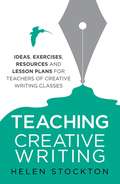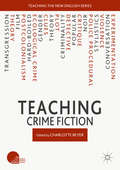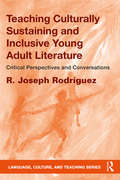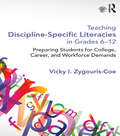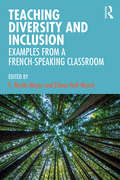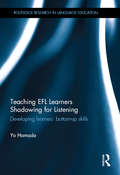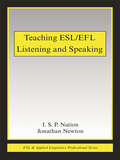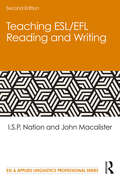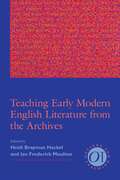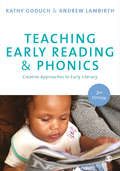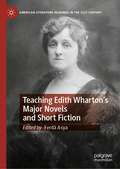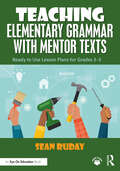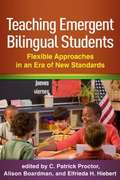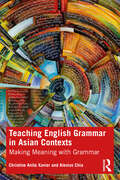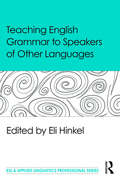- Table View
- List View
Teaching Creative Writing in Asia
by Darryl WhetterThis book examines the dynamic landscape of creative educations in Asia, exploring the intersection of post-coloniality, translation, and creative educations in one of the world’s most relevant testing grounds for STEM versus STEAM educational debates. Several essays attend to one of today’s most pressing issues in Creative Writing education, and education generally: the convergence of the former educational revolution of Creative Writing in the anglophone world with a defining aspect of the 21st-century—the shift from monolingual to multilingual writers and learners. The essays look at examples from across Asia with specific experience from India, Singapore, China, Hong Kong, the Philippines and Taiwan. Each of the 14 writer-professor contributors has taught Creative Writing substantially in Asia, often creating and directing the first university Creative Writing programs there. This book will be of interest to anyone following global trends within creative writing and those with an interest in education and multilingualism in Asia.
Teaching Creative Writing in Canada (Routledge Studies in Creative Writing)
by Darryl WhetterTeaching Creative Writing in Canada maps the landscape of Creative Writing programmes across Canada. Canada’s position, both culturally and physically, as a midpoint between the two major Anglophone influences on Creative Writing pedagogyy—the UK and the USA—makes it a unique and relevant vantage for the study of contemporary Creative Writing pedagogy.Showcasing writer-professors from Canada’s major Creative Writing programmes, the collection considers the climate-crisis, contemporary workshop scepticism, curriculum design, programme management, prize culture, grants and interdisciplinarity. Each chapter concludes with field-tested writing advice from many of Canada’s most influential professors of fiction, poetry, creative nonfiction and drama.This authoritative volume offers an important national perspective on contemporary and timeless issues in Creative Writing pedagogy and their varied treatment in Canada. It will be of valuable to other creative teachers and practitioners, those with an interest in teaching and learning a creative art and anyone working on cultural and educational landscapes.
Teaching Creative Writing: Ideas, exercises, resources and lesson plans for teachers of creative-writing classes
by Helen StocktonIf you teach creative writing or facilitate a writing group, you will want to inspire, inform and encourage would-be writers. This book is a unique, practical resource offering guidance, ideas and exercises to help you do just that. It moves from planning and structuring courses to giving ideas and exercises on all the key aspects of creative writing, providing a wealth of really useful advice and tips. It will enable you to pass on your particular expertise and enthusiasm imaginatively and professionally to all your students.· Guidance on teaching all the skills of creative writing· Ideas on lesson content, example exercises and setting homework· Support on dealing with problems and adapting for different abilities· Tips on group management and feedback· A ? Z of specific genres with examples of learning activities.This book will ensure that your teaching will be effective, fun and immensely rewarding.
Teaching Creative Writing: Ideas, exercises, resources and lesson plans for teachers of creative-writing classes
by Helen StocktonIf you teach creative writing or facilitate a writing group, you will want to inspire, inform and encourage would-be writers. This book is a unique, practical resource offering guidance, ideas and exercises to help you do just that. It moves from planning and structuring courses to giving ideas and exercises on all the key aspects of creative writing, providing a wealth of really useful advice and tips. It will enable you to pass on your particular expertise and enthusiasm imaginatively and professionally to all your students.· Guidance on teaching all the skills of creative writing· Ideas on lesson content, example exercises and setting homework· Support on dealing with problems and adapting for different abilities· Tips on group management and feedback· A – Z of specific genres with examples of learning activities.This book will ensure that your teaching will be effective, fun and immensely rewarding.
Teaching Crime Fiction (Teaching the New English)
by Charlotte BeyerMore than perhaps any other genre, crime fiction invites debate over the role of popular fiction in English studies. This book offers lively original essays on teaching crime fiction written by experienced British and international scholar teachers, providing vital insight into this diverse genre through a series of compelling subjects. Taking its starting-point in pedagogical reflections and classroom experiences, the book explores methods for teaching students to develop their own critical perspectives as crime fiction critics, the impact of feminism, postcolonialism, and ecocriticism on crime fiction, crime fiction and film, the crime short story, postgraduate perspectives, and more.
Teaching Culturally Sustaining and Inclusive Young Adult Literature: Critical Perspectives and Conversations (Language, Culture, and Teaching Series)
by R. Joseph RodríguezIn this book, Rodríguez uses theories of critical literacy and culturally responsive teaching to argue that our schools, and our culture, need sustaining and inclusive young adult (YA) literature/s to meet the needs of culturally and linguistically diverse readers and all students. This book provides an outline for the study of literature through cultural and literary criticism, via essays that analyze selected YA literature (drama, fiction, nonfiction, and poetry) in four areas: scribal identities and the self-affirmation of adolescents; gender and sexualities; schooling and education of young adult characters; and teachers’ roles and influences in characters’ coming of age. Applying critical literacy theories and a youth studies lens, this book shines a light on the need for culturally sustaining and inclusive pedagogies to read adolescent worlds. Complementing these essays are critical conversations with seven key contemporary YA literature writers, adding biographical perspectives to further expand the critical scholarship and merits of YA literature.
Teaching Discipline-Specific Literacies in Grades 6-12: Preparing Students for College, Career, and Workforce Demands
by Vicky I. Zygouris-CoeComprehensive, timely, and relevant, this text offers an approach to discipline-specific literacy instruction that is aligned with the Common Core State Standards and the needs of teachers, students, and secondary schools across the nation. It is essential that teachers know how to provide instruction that both develops content and literacy knowledge and skills, and aims at reducing student achievement gaps. Building on the research-supported premise that discipline-specific reading instruction is key to achieving these goals, this text provides practical guidance and strategies for prospective and practicing content area teachers (and other educators) on how to prepare all students to succeed in college and the workforce. Pedagogical features in each chapter engage readers in digging deeper and in applying the ideas and strategies presented in their own contexts: Classroom Life (real 6-12 classroom scenarios and interviews with content-area teachers) Common Core State Standards Connections College, Career, and Workforce Connections Applying Discipline-Specific Literacies Think Like an Expert ("habits of thinking and learning" specific to each discipline) Digital Literacies Differentiating Instruction Reflect and Apply Questions Extending Learning Activities The Companion Website includes: Lesson plan resources Annotated links to video files Annotated links to additional resources and information Glossary/Flashcards For Instructors: All images and figures used in the text provided in an easily downloadable format For Instructors: PowerPoint lecture slides
Teaching Diversity and Inclusion: Examples from a French-Speaking Classroom
by E. Nicole MeyerTeaching Diversity and Inclusion: Examples from a French-Speaking Classroom explores new and pioneering strategies for transforming current teaching practices into equitable, inclusive and immersive classrooms for all students. This cutting-edge volume dares to ask new questions, and shares innovative, concrete tools useful to a wide variety of classrooms and institutional contexts, far beyond any disciplinary borders. This book aims to instill classroom approaches which allow every student to feel safe to share their truth and to reflect deeply about their own identity and challenges, discussing course design, assignments, technologies, activities, and strategies that target diversity and inclusion in the French classroom. Each chapter shares why and how to design an inclusive community of learners, including opportunities to promote interdisciplinary approaches and cross-disciplinary collaborations, exploring cultures and underrepresented perspectives, and distinguishing unconscious biases. The essays also provide theoretical and practical strategies adaptable to any reflective teacher desiring to create a welcoming, inclusive classroom that draws in students they might not otherwise attract. This long overdue work will be ideal for both undergraduate and graduate students and administrators seeking fresh approaches to diversity in the classroom.
Teaching EFL Learners Shadowing for Listening: Developing learners' bottom-up skills (Routledge Research in Language Education)
by Yo HamadaShadowing, an active and highly cognitive technique for EFL listening skill development, in which learners track heard speech and vocalize it simultaneously, is gradually becoming recognized. However, there remain a lot of mysteries and misunderstandings about it. This book uncovers shadowing in terms of theory and practice. This book cements shadowing as a separate technique from other similar techniques such as Elicited Imitation, Mirroring, and simple repetition, and provides ample empirical data to explain the function of Shadowing. It also elaborates on how Shadowing should be used in terms of materials, procedure, and learners’ psychology, which would aid in instructors’ use of Shadowing in teaching. A guide on a method effective in improving learners’ bottom-up listening skills, this book will certainly prove useful to English Language learners and instructors in their linguistic pursuits.
Teaching EFL Writing in the 21st Century Arab World
by Abdelhamid Ahmed Hassan AbouabdelkaderTeaching EFL Writing in the 21st Century Arab World addresses a range of issues related to researching and teaching EFL writing in different countries in the Arab World including Egypt, Morocco, Oman, Palestine, Tunisia, UAE and Yemen. Both theoretically and practically grounded, chapters within discuss the different contexts in which EFL writing is taught, from primary school to university. The book sheds light on how EFL writing is learned and taught at each educational stage, exposing the different challenges encountered in the teaching and learning. The focus on EFL writing in the Arab World makes this a unique and long overdue contribution to the field of research around EFL writing and will be an invaluable resource for researchers, curriculum designers and students.
Teaching ESL/EFL Listening and Speaking (ESL & Applied Linguistics Professional Series)
by I.S.P. Nation Jonathan NewtonUsing a framework based on principles of teaching and learning, this guide for teachers and teacher trainees provides a wealth of suggestions for helping learners at all levels of proficiency develop their listening and speaking skills and fluency. By following these suggestions, which are organized around four strands - meaning-focused input, meaning-focused output, language-focused learning, and fluency development - teachers will be able to design and present a balanced program for their students. Teaching ESL/EFL Listening and Speaking, and its companion text, Teaching ESL/EFL Reading and Writing, are similar in format and the kinds of topics covered, but do not need to be used together. Drawing on research and theory in applied linguistics, their focus is strongly hands-on, featuring easily applied principles, a large number of useful teaching techniques, and guidelines for testing and monitoring. All Certificate, Diploma, Masters and Doctoral courses for teachers of English as a second or foreign language include a teaching methods component. The texts are designed for and have been field tested in such programs.
Teaching ESL/EFL Listening and Speaking (ESL & Applied Linguistics Professional Series)
by Jonathan M. Newton I.S.P. NationThis guide for teachers and teacher trainees provides a wealth of suggestions for helping learners at all levels of proficiency develop their listening and speaking skills and fluency, using a framework based on principles of teaching and learning. By following these suggestions, which are organized around four strands – meaning-focused input, meaning-focused output, language-focused learning, and fluency development – teachers will be able to design and present a balanced program for their students. Updated with cutting-edge research and theory, the Second Edition of Teaching ESL/EFL Listening and Speaking retains its hands-on focus and engaging format, and features new activities and information on emerging topics, including: Two new chapters on Extensive Listening and Teaching Using a Course Book Expanded coverage of key topics, including assessment, pronunciation, and using the internet to develop listening and speaking skills Easy-to-implement tasks and suggestions for further reading in every chapter More tools for preservice teachers and teacher trainers, such as a sample unit, a "survival syllabus," and topic prompts The second edition of this bestselling book is an essential text for all Certificate, Diploma, Masters and Doctoral courses for teachers of English as a second or foreign language.
Teaching ESL/EFL Reading and Writing (ESL & Applied Linguistics Professional Series)
by I.S.P. NationUsing a framework based on principles of teaching and learning, this guide for teachers and teacher trainees provides a wealth of suggestions for helping learners at all levels of proficiency develop their reading and writing skills and fluency. By following these suggestions, which are organized around four strands – meaning-focused input, meaning-focused output, language-focused learning, and fluency development – teachers will be able to design and present a balanced program for their students. Teaching ESL/EFL Reading and Writing, and its companion text, Teaching ESL/EFL Listening and Speaking, are similar in format and the kinds of topics covered, but do not need to be used together. Drawing on research and theory in applied linguistics, their focus is strongly hands-on, featuring easily applied principles, a large number of useful teaching techniques, and guidelines for testing and monitoring, All Certificate, Diploma, Masters and Doctoral courses for teachers of English as a second or foreign language include a teaching methods component. The texts are designed for and have been field tested in such programs.
Teaching ESL/EFL Reading and Writing (ESL & Applied Linguistics Professional Series)
by John Macalister I.S.P. NationThe second edition of this bestselling text, Teaching ESL/EFL Reading and Writing, is a fully updated and expanded guide for teaching learners at all levels of proficiency how to develop their reading and writing skills and fluency. Practical and accessible, this book covers a diverse array of language teaching techniques suitable for all contexts. Updated with cutting-edge research and theory, the second edition is an essential and engaging text. Key insights and suggestions are organised around four strands – meaning-focused input, meaning-focused output, language-focused learning, and fluency development – to allow teachers to design and present a balanced programme for their students. Bringing together research and theory in applied linguistics and education, the text includes useful examples and practical strategies and features new topics related to technology, assessment, and genre. The second edition includes new tasks and further reading sections in every chapter. Teaching ESL/EFL Reading and Writing is designed for practising and pre-service teachers of all levels, and is ideal for certificate, diploma, masters, and doctoral courses in English as a second or foreign language.
Teaching Early Modern English Literature from the Archives (Options for Teaching #36)
by Heidi Brayman Hackel and Ian Frederick MoultonThe availability of digital editions of early modern works brings a wealth of exciting archival and primary source materials into the classroom. But electronic archives can be overwhelming and hard to use, for teachers and students alike, and digitization can distort or omit information about texts. Teaching Early Modern English Literature from the Archives places traditional and electronic archives in conversation, outlines practical methods for incorporating them into the undergraduate and graduate curriculum, and addresses the theoretical issues involved in studying them. The volume discusses a range of physical and virtual archives from 1473 to 1700 that are useful in the teaching of early modern literature--both major sources and rich collections that are less known (including affordable or free options for those with limited institutional resources).Although the volume focuses on English literature and culture, essays discuss a wide range of comparative approaches involving Latin, French, Spanish, German, and early American texts and explain how to incorporate visual materials, ballads, domestic treatises, atlases, music, and historical documents into the teaching of literature.
Teaching Early Reading and Phonics
by Kathy Goouch Andrew LambirthTeaching Early Reading and Phonics: Creative Approaches to Early Literacy supports teachers using phonics in their teaching of early reading. The authors show how important it is to ensure that children acquire a wide range of reading strategies, while also setting out practical ’pointers’ which will enable teachers to translate the theory into effective practice. Readers will learn how to plan phonics within a rich, interactive and playful literacy pedagogy; how to construct relationships with the young readers in their classes and the texts around them; how to embed the teaching of phonics in carefully selected high quality materials – particularly in children’s literature. Written for practicing teachers, student teachers on initial teacher training courses at undergraduate and graduate levels, the book will also be useful for advisors working on continuing professional development.
Teaching Early Reading and Phonics: Creative Approaches to Early Literacy
by Kathy Goouch Andrew LambirthLearning to read is an exciting and vital part of every child’s development. The new edition of this book continues to provide trainees and teachers with a broad understanding of teaching reading and phonics, and equip them with the skills necessary to face the reality of the early years classroom in order to meet the needs of individual children. With vital information on constructing relationships with young readers, and how to plan phonics within a rich, interactive and playful literacy pedagogy, the second edition now includes: A brand new chapter on babies and early reading More information on language acquisition and how children learn A discussion of children with SEN An appreciation for the rise of digital technologies in relation to reading Whether you're training to become a teacher, or already working in the classroom this book is ideal for those who wish to embed the teaching of phonics into carefully selected high quality materials - particularly in children's literature.
Teaching Early Reading and Phonics: Creative Approaches to Early Literacy
by Kathy Goouch Andrew LambirthLearning to read is an exciting and vital part of every child’s development. The new edition of this book continues to provide trainees and teachers with a broad understanding of teaching reading and phonics, and equip them with the skills necessary to face the reality of the early years classroom in order to meet the needs of individual children. With vital information on constructing relationships with young readers, and how to plan phonics within a rich, interactive and playful literacy pedagogy, the second edition now includes: A brand new chapter on babies and early reading More information on language acquisition and how children learn A discussion of children with SEN An appreciation for the rise of digital technologies in relation to reading Whether you′re training to become a teacher, or already working in the classroom this book is ideal for those who wish to embed the teaching of phonics into carefully selected high quality materials - particularly in children′s literature.
Teaching Ecocriticism and Green Cultural Studies
by Greg GarrardEcocriticism is one of the most vibrant fields of cultural study today, and environmental issues are controversial and topical. This volume captures the excitement of green reading, reflects on its relationship to the modern academy, and provides practical guidance for dealing with global scale, interdisciplinarity, apathy and scepticism.
Teaching Edith Wharton’s Major Novels and Short Fiction (American Literature Readings in the 21st Century)
by Ferdâ AsyaThis book translates recent scholarship into pedagogy for teaching Edith Wharton’s widely celebrated and less-known fiction to students in the twenty-first century. It comprises such themes as American and European cultures, material culture, identity, sexuality, class, gender, law, history, journalism, anarchism, war, addiction, disability, ecology, technology, and social media in historical, cultural, transcultural, international, and regional contexts. It includes Wharton’s works compared to those of other authors, taught online, read in foreign universities, and studied in film adaptations.
Teaching Elementary Grammar with Mentor Texts: Ready to Use Lesson Plans for Grades 3–5
by Sean RudayTeaching Elementary Grammar with Mentor Texts: Ready to Use Lesson Plans for Grades 3–5 contains detailed grammar lesson plans for teachers in grades three, four, and five. The lesson plans in this book incorporate the research-based best practices of grammar instruction and apply those practices to the teaching and learning of grammar instruction. They present grammatical concepts in the context of effective writing by using mentor texts. These mentor text examples, which students read from a writer’s perspective, deepen students’ metacognition of the importance of grammatical concepts and help them see the elements of grammar as tools for strong writing that authors use strategically to make their work as strong as possible. The book provides elementary school teachers with user-friendly lesson plans that they can easily use to put mentor text-based grammar instruction into action in their classrooms. These lesson plans feature published examples of grammatical concepts from contemporary children’s and middle-grade books, activities that help students connect their reading and writing experiences, and reflective activities that facilitate students’ metacognition of the importance of grammatical concepts. The thorough plans in this book will help teachers put the best practices of grammar instruction into action in concrete, practitioner-oriented ways.
Teaching Emergent Bilingual Students: Flexible Approaches in an Era of New Standards
by Elfrieda H. Hiebert Alison Boardman C. Patrick ProctorRecent educational reform initiatives such as the Common Core State Standards (CCSS) largely fail to address the needs--or tap into the unique resources--of students who are developing literacy skills in both English and a home language. This book discusses ways to meet the challenges that current standards pose for teaching emergent bilingual students in grades K-8. Leading experts describe effective, standards-aligned instructional approaches and programs expressly developed to promote bilingual learners' academic vocabulary, comprehension, speaking, writing, and content learning. Innovative policy recommendations and professional development approaches are also presented.
Teaching English Grammar in Asian Contexts: Making Meaning with Grammar
by Christine Xavier Alexius ChiaThis book guides teachers, teacher educators and pre-service student teachers on using grammar as a pedagogical tool for meaning making, linking grammar as a meaning-making resource to literacy development. When grammar is meaningfully linked to literacy skills such as reading and writing, there is contextualised teaching of grammar.The authors thoroughly explore key concepts in grammar, including grammar as structure and grammar as choice. They illuminate these concepts by analysing a range of authentic texts from Asian contexts, showing how specific grammar features are purposefully used to convey meaning. Examples and illustrations of teaching ideas and materials focusing on contextualised teaching of grammar, including lesson plans, activity outlines, worksheets and teaching strategies, are contributed by current teacher practitioners who have tried out these ideas in their language classes. These teacher practitioners also share their reflections on how these ideas have worked in their classes.As a result, this book is an indispensable resource for teachers, teacher educators, pre-service teachers of English as both a first language and a second or foreign language, as well as anyone who is interested in harnessing the power of grammar to enhance English language teaching and literacy development.
Teaching English Grammar to Speakers of Other Languages (ESL & Applied Linguistics Professional Series)
by Eli HinkelThis practical and research-based introduction to current and effective English grammar instruction gives pre-service and in-service teachers and teacher educators a strong foundation for teaching second language grammar and helps them develop their professional knowledge and skills. Written in a highly readable style for an international audience, it provides a thorough and rounded overview of the principles, strategies, techniques, and applications currently dominant in teaching L2 grammar in a range of instructional settings around the world. Chapter authors are world-class authorities in grammar and grammar teaching and learning. All chapters are based on theoretical frameworks and/or research foundations with a strong emphasis on practical applications and implications for classroom teaching, and highlight teaching methods, key concepts, and terminology associated with grammar instruction. Illuminating the options and choices in grammar teaching from a contemporary perspective, Teaching English Grammar to Speakers of Other Languages is ideal as key text for students in undergraduate and graduate MA-TESOL programs and as a resource for practicing ESL/EFL teachers, teacher educators, and teaching faculty.
Teaching English Language Learners in Career and Technical Education Programs
by Victor M. Hernández-Gantes William BlankExploring the unique challenges of vocational education, this book provides simple and straightforward advice on how to teach English Language Learners in today's Career and Technical Education programs. The authors' teaching framework and case studies draw from common settings in which career and technical educators find themselves working with ELLs—in the classroom, in the laboratory or workshop, and in work-based learning settings. By integrating CTE and academic instruction, and embedding career development activities across the curriculum, readers will gain a better understanding of the challenges of teaching occupationally-oriented content to a diverse group of learners in multiples settings.


